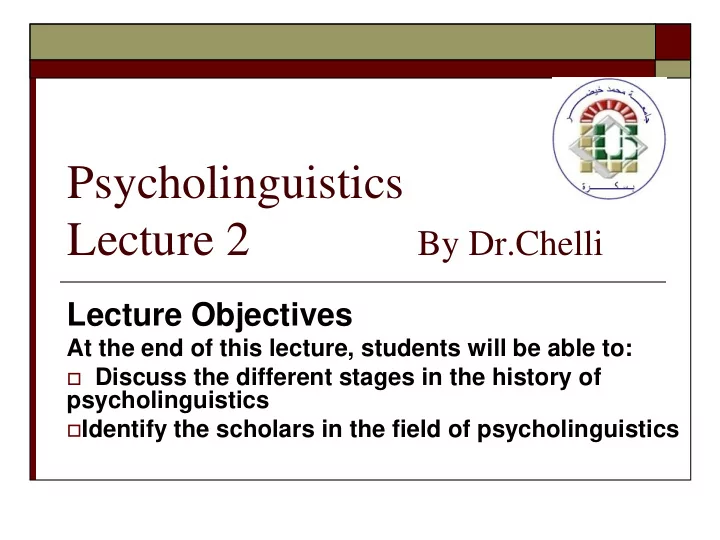

Psycholinguistics Lecture 2 By Dr.Chelli Lecture Objectives At the end of this lecture, students will be able to: Discuss the different stages in the history of psycholinguistics Identify the scholars in the field of psycholinguistics
Introduction Any discipline has a history behind its development including stages which entail the contributions of great minds that have shaped the discipline and in this regard, psycholinguistics is no exception (Kess, 1992)
According to Levelt (2014), the scientific study of how we speak and understand language was launched during the 1950s with the advent of Noam Chomsky’s generative linguistics.
True, modern psycholinguistics received a major impulse from ‘ cognitive revolution ’, but the empirical study of how we speak and listen and how children acquire these amazing skills has its roots in the late 18th century.
By the end of the 19th century, the psychology of language was an established science and the field was booming up to World War II.
Therefore based on this litearture, this lecture traces the stages of the history of linguistics to: Pre- Chomskyan era Chomskyan era
1. Pre- Chomskyan era Some scientists contributed to the birth of psycholinguistics in this era in studies of how we speak and listen and how children acquire these skills in the 18th century . We can name : The Viennese engineer Wolfgang Kempelen , spent 20 years constructing a “ speaking machine” which can articulate complex utterances. It was the first serious model of the vocal tract
Aitchison (1990) asserts that the first known experiment in psycholinguistics was conducted by the German philosopher, Dietrich Tiedman , who used his son to record the linguistic development.
Frantz Joseph Gall was another scientist who developed serious brain anatomy in the late 18th century in which he proposed the theory that mental faculties such as the memory for words were localized in specific areas.
This was followed by the localization of two important areas involved in the production and understanding of speech: Broca’ s area (1865) involved in the production of speech ( advanced by Paul Broca). Wernicke’s area ( 1874) involved in speech understanding ( advanced by Carl Wernicke)
The original description of Broca’s and Wernicke aphasiasis were of particular importance for the emergence of psycholinguistics as an independent discipline.
But concrete work came form the work of Wilhem Wundt (1832-1920) who was regarded as the father of experimental psychology as he founded the first official laboratory of psychological research at the University of Leipniz, Germany (1878).
In addition, he published a book on languages including a number of topics such as child language acquisition, sign language, language perception and grammatical structure which are skills relevant to psycholinguistics. He believed that mental states were important and viewed sentence as the key unit of language and tried to prove the influence of its production and comprehension.
In the middle of the 20th century, the field of psycholinguistics started flourishing due to scholars’ interest. The strongly empiricism and anti-mentalist attitude to science which dominated both linguistics and psychology during the first half of the twenties century ( behaviouristic linguistics) inhibited theorizing about mental processes involved in linguistic behaviour,
and it was not until the late 1950s and early 1960s that the work of Noam Chomsky (Transformational- Generative Grammar) provided a climate of thought in which the discipline could flourish (Williams, 2001). According to Aitchison (2001), ‘the general feeling and belief is that the field grew out of the research efforts of Noam Chomsky and philosophy of language’
Reber (1987) asserts that psycholinguistics has its beginning in the pre-20th century but nevertheless re-invented itself in the middle of the century.
By the 1950s and 1960s, the field has grown due to the works of a number of scholars such as : Noam Chomsky, Zellig Harris, George Miller, Karl Lashley, Charles Osgood, John Carroll, Thomas Sebeok, and Herbert Simon among a host of others.
In addition to Chomsky’s theory, one of the fundations of the modern era consists of: two seminars sponsored by the Social Science Research Council and the publication of Osgood and Sebeok (1950): Psycholinguistics: A survey of theory and research problems.
The main impetus of psycholinguistics research in the 1960s was to explore the psychological reality of grammars produced by linguists, that is to try to show that these in some way mirror what went on the speaker’s and hearer’s minds.
We can add that psycholinguistics research on child language acquisition heavily relied on the Transformational model and was later adapted for the processing and comprehension of speech.
However, there has also been a general shift within psycholinguistics during the 1970s and 1980s away from models which take as their starting point towards more psychologically based models.
Modern psycholinguistics has turned to new functionally related models of language structure research because the results of earlier work showed controversy and inconclusiveness.
References Harley, T. (2001). The psychology of language: from data to theory. Taylor & Francis Gropu: Psychology Press Kess, J.F. (1992). Psychology, linguistics, and the study of natural language. John Benjamins Publishing Company. Levelt, Willen, J.M. ( 2014 ). A history of psycholinguistics: The pre- Chomskyan era. Oxford: Oxford University Press.
Assignment 1. Refer to the two previous lectures and other powerpoints you will be provided with and write and essay in which you introduce psycholinguistics. 2. Summarize the article entitled ‘ relations between psycholinguistic approach and foreign language learning.
Recommend
More recommend